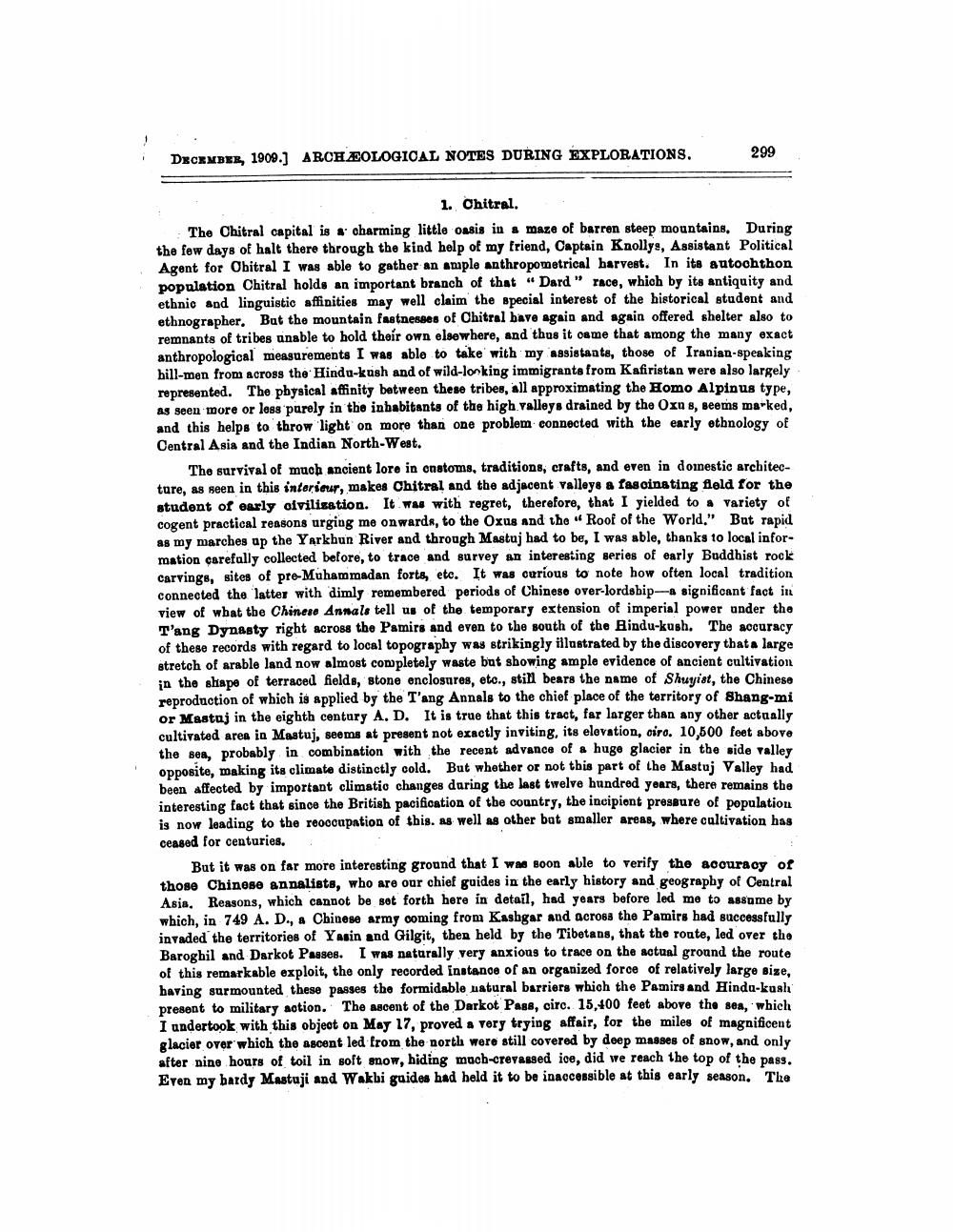________________
DECEMBER, 1909.) ARCHÆOLOGICAL NOTES DURING EXPLORATIONS.
299
1. Chitral. The Chitral capital is a charming little oasis in a maze of barren steep mountains. During the few days of halt there through the kind help of my friend, Captain Knollys, Assistant Political Agent for Obitral I was able to gather an ample anthropometrical harvest. In its autochthon population Chitral holds an important branch of that “Dard" race, which by its antiquity and ethnio apd linguistio affinities may well claim the special interest of the historical student and ethnographer, Bat the mountain fastnesses of Chitral bave again and again offered shelter also to remnants of tribes unable to hold their own elsewhere, and thus it came that among the many exact anthropological measurements I was able to take with my assistaats, those of Iranian-speaking hill-men from across the Hindu-kush and of wild-looking immigrants from Kafiristan were also largely represented. The physical affinity between these tribes, all approximating the Homo Alpinus type, as seen more or less purely in the inbabitants of the high valleys drained by the Oxos, seems marked, and this helps to throw light on more than one problem connected with the early ethnology of Central Asia and the Indian North-West.
The survival of much ancient lore in cnatoms, traditions, crafts, and even in doinestic architecture, as seen in this interieur, makes Chitral and the adjacent Valleys a fascinating field for the student of early olvilization. It was with regret, therefore, that I yielded to a variety of cogent practical reasons urging me onwards, to the Oxus and the Roof of the World." But rapid as my marches ap the Yarkhun River and through Mastuj had to be, I was able, thanks to local information carefully collected before, to trace and survey an interesting series of early Buddhist rock Carvings, sites of pre-Muhammadan forts, etc. It was curious to note how often local tradition connected the latter with dimly remembered periods of Chinese over-lordsbip-- significant fact in view of wbat the Chinese Annals tell us of the temporary extension of imperial power under the T'ang Dynasty right across the Pamirs and even to the south of the Rindu-kush. The accuracy of these records with regard to local topography was strikingly illustrated by the discovery thata large stretch of arable land now almost completely waste but showing ample evidence of ancient cultivation in the shape of terraced fields, stone enclosures, etc., still bears the name of Shuyist, the Chinese reproduction of which is applied by the T'ang Annals to the chief place of the territory of Shang-mi or Mastaj in the eighth century A. D. It is true that this tract, far larger than any other actually cultivated area in Mastuj, seems at present not exactly inviting, its elevation, oiro. 10,500 feet above the sea, probably in combination with the recent advance of a huge glacier in the side valley opposite, making its climate distinctly cold. But whether or not this part of the Mastuj Valley had been affected by important climatic changes during the last twelve hundred years, there remains the interesting fact that since the British pacification of the country, the incipient pressure of population is now leading to the reoccupation of this. As well as other bat smaller areas, where caltivation has ceased for centuries.
But it was on far more interesting ground that I was soon able to verify the accuracy of those Chinese annalists, who are our chief guides in the early history and geography of Central Asia. Reasons, which cannot be set forth here in detail, had years before led me to assume by which, in 749 A. D., a Chinese army coming from Kashgar and across the Pamirs had successfully invaded the territories of Yasin and Gilgit, then held by the Tibetans, that the route, led over the Baroghil and Darkot Passes. I was naturally very anxious to trace on the actual ground the route of this remarkable exploit, the only recorded instance of an organized force of relatively large size, having surmounted these passes the formidable uatural barriers which the Pamirs and Hinda-kush present to military action. The ascent of the Darkot Pass, circ. 15,400 feet above the sea, which I undertook with this object on May 17, proved a very trying affair, for the miles of magnificent glacier over which the ascent led from the north were still covered by deep masses of snow, and only after nine hours of toil in soft snow, hiding mach-crevassed ice, did we reach the top of the pass. Even my bardy Mastuji and Wakbi gaides had held it to be inaccessible at this early season. The




